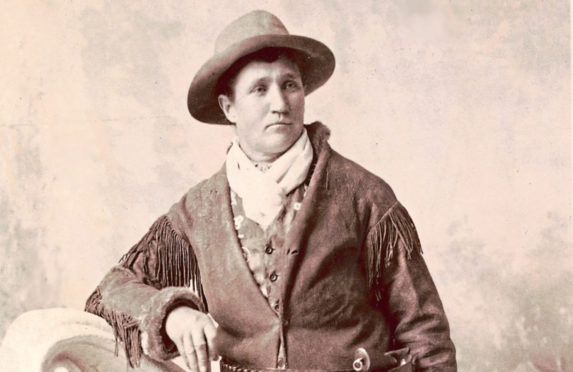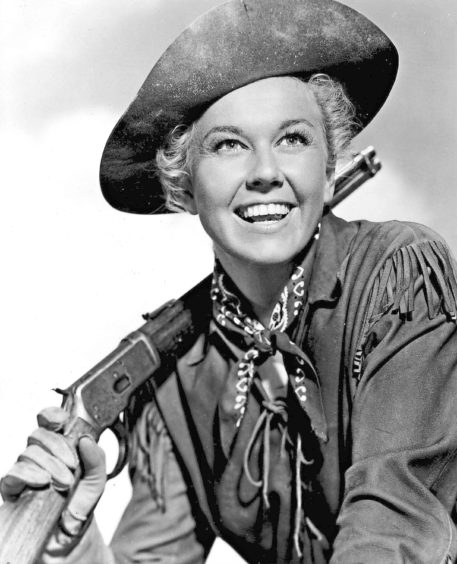
The real Calamity Jane bore little resemblance – physically at least – to Doris Day’s likeable performance in the 1953 screen musical.
According to a new book, Martha Jane Canary, to give Calamity Jane her proper name, was a hard-drinking, cross-dressing, foul-mouthed maverick who created her own legend.
The Wild West was full of self-styled heroes and villains – Buffalo Bill, Davy Crockett, Jesse James and Billy the Kid – to name a few.
If you were charismatic, uninhibited and you spun a good yarn, nobody really cared if your stories were fact or fantasy.
In 1896 Martha Jane published a memoir, Life & Adventures Of Calamity Jane, By Herself, a brief chronicle of her life as a frontier scout, which she dictated to someone else as she could neither read nor write.
In her book, The Many Lives Of Calamity Jane, author Karen R Jones casts doubt over the accuracy of Martha’s tales as she was known to play fast and loose with the truth.
Jones writes: “In large part, Life & Adventures was hokum – an exercise in creative writing and myth-making. Calamity Jane never rode with Custer (as she claimed), never served as an army scout, or a Pony Express courier, and did not apprehend Wild Bill Hickok’s killer.”
She had, as Jones puts it, “a keen sense of theatricality” and as a saloon bar storyteller she talked the talk. In that respect, Doris Day’s exuberant performance was spot on.
Surviving photographs of Martha Jane reveal her as stocky, scruffy, earnest-looking and usually dressed in men’s clothing, complete with a battered trilby hat at a jaunty angle. Feminine she was not, unlike Doris Day’s “Calam” who, though similarly clad in traditional buckskin garb, managed to look as glamorous and appealing as ever.
The film also made much of the romance between Martha Jane and Bill Hickok, for which there is little known evidence. They were certainly well acquainted, since they both resided in Deadwood, South Dakota, at the same time, and it is possible they may have had a liaison, but Karen Jones thinks it unlikely.
Martha Jane was also acquainted with Buffalo Bill Cody – later in life she appeared in his hugely successful Wild West extravaganzas – and he was called upon to pay tribute to her when she died in 1903.
Cody wrote at the time: “Calamity was different from any woman I ever knew. Only the old days could have produced her. There are probably few of the old timers living that have seen more of the lively times in the early days. She was generally in the thick of what was going on” adding that “everyone knew and liked her”.
By the time she died, Calamity Jane’s fame or notoriety had spread across America, thanks to the so-called “dime novels” inspired by her adventures. The New York Times called her “the most picturesque character in the west”, writing that her celebrity status “led thousands of visitors to travel miles out of their way to see her”.
In a way, the legend of Calamity Jane got a whole lot bigger after she died, with a succession of hack biographies, novels, plays, movies and even an opera, each one moving further and further away from the real Martha Jane.
In terms of films, the first one appeared as far back as 1915 in which Calamity appeared as a sidekick to Wild Bill Hickok’s stalwart scout. A similar scenario prevailed in Wild Bill Hickok (1923), with Jane as the frontiersman’s hard-drinking helpmate and would-be lover.
Meanwhile in Deadwood – the town in which Martha Jane and Bill Hickok encountered each other – an annual parade was inaugurated in 1924 featuring horse-drawn wagons, gun-toting cowboys and actors dressed up as popular frontier heroes. Calamity Jane dolls were available to buy as keepsakes.
The first “talkie” of any consequence was Cecil B DeMille’s The Plainsman (1936) starring Gary Cooper as Wild Bill Hickok and Jean Arthur as Calamity Jane, but again her role was primarily to act as an eccentric support act to the heroics of Hickok and Buffalo Bill.
In her book, Karen Jones writes of Jean Arthur’s performance: “Her take on the frontier heroine was tomboyish and courageous and presented a view of the western woman as independent, capable and existing beyond the male gaze.”
In The Badlands of Dakota (1941), Frances Farmer is the stage driver in love with the roguish owner of a Deadwood saloon who, in the film’s climax, shoots him dead after he falls in with a bunch of outlaws. In the final scene she says to the bartender in her victim’s bar: “Don’t you know when a lady needs a drink?”
As somebody remarked at the time: “Calamity Jane is rapidly becoming a peg on which to hang a western.”
In the 1948 comedy The Paleface, Jane Russell took Hollywood’s glamorous re-invention of Calamity Jane to new heights, marrying a timid and accident-prone dentist (Bob Hope) as a cover for an undercover operation.
But it was the 1953 musical comedy Calamity Jane, with girl-next-door Doris Day showing a whole new side of her talent, that everyone remembers, both for Day’s full-blooded performance and for the catchy musical numbers, including Secret Love which won that year’s Oscar for Best Song.
In keeping with the gender politics of the time, Calamity Jane was “tamed” by Howard Keel’s Wild Bill Hickok by the end of the film, replacing her manly buckskin trouser suit for a flouncy dress.
But the Calamity Jane rollercoaster didn’t stop there. There have been countless other celluloid Calamity Janes, including Jane Alexander in a made-for-TV film in 1984, Ellen Barkin in the 1995 film Wild Bill, Anjelica Huston in Buffalo Girls (1995) and Robin Weigert in Deadwood: The Movie, last year.
Could the reason she has fascinated so many writers and film-makers be that, despite being lauded as an icon of the Wild West, nobody really knows the truth of the legend?
Calamity: The Many Lives Of Calamity Jane by Karen R Jones is published by Yale University Press and available now.

Enjoy the convenience of having The Sunday Post delivered as a digital ePaper straight to your smartphone, tablet or computer.
Subscribe for only £5.49 a month and enjoy all the benefits of the printed paper as a digital replica.
Subscribe © Warner Bros/Kobal/Shutterstock
© Warner Bros/Kobal/Shutterstock